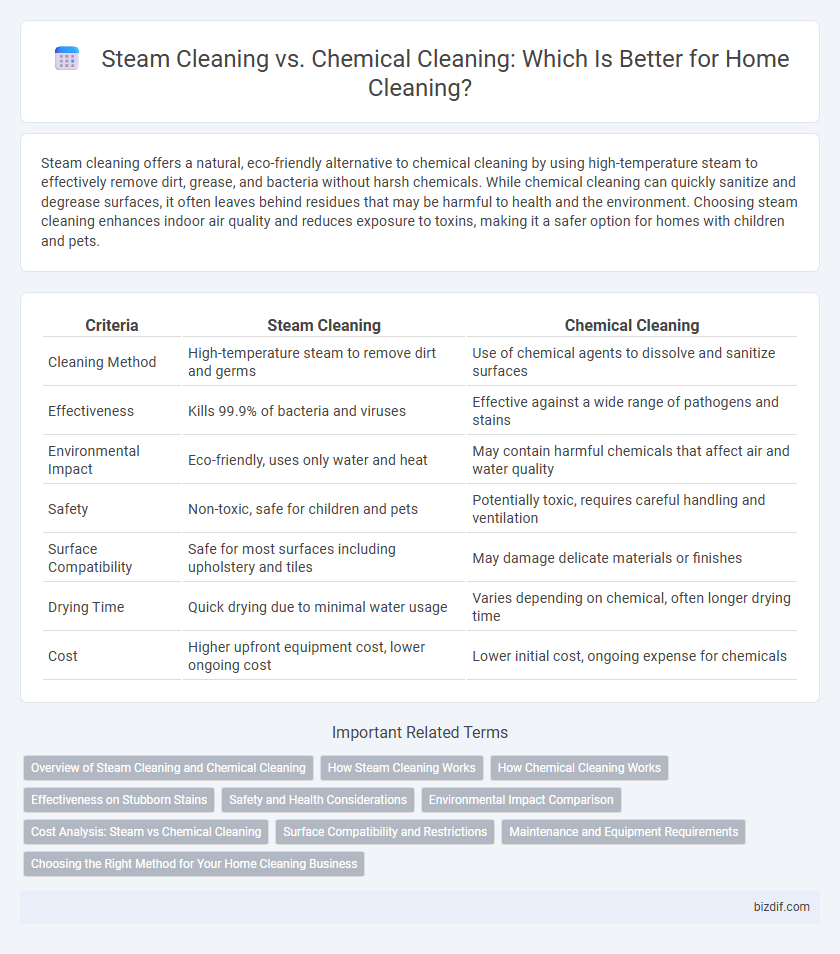Steam cleaning offers a natural, eco-friendly alternative to chemical cleaning by using high-temperature steam to effectively remove dirt, grease, and bacteria without harsh chemicals. While chemical cleaning can quickly sanitize and degrease surfaces, it often leaves behind residues that may be harmful to health and the environment. Choosing steam cleaning enhances indoor air quality and reduces exposure to toxins, making it a safer option for homes with children and pets.
Table of Comparison
| Criteria | Steam Cleaning | Chemical Cleaning |
|---|---|---|
| Cleaning Method | High-temperature steam to remove dirt and germs | Use of chemical agents to dissolve and sanitize surfaces |
| Effectiveness | Kills 99.9% of bacteria and viruses | Effective against a wide range of pathogens and stains |
| Environmental Impact | Eco-friendly, uses only water and heat | May contain harmful chemicals that affect air and water quality |
| Safety | Non-toxic, safe for children and pets | Potentially toxic, requires careful handling and ventilation |
| Surface Compatibility | Safe for most surfaces including upholstery and tiles | May damage delicate materials or finishes |
| Drying Time | Quick drying due to minimal water usage | Varies depending on chemical, often longer drying time |
| Cost | Higher upfront equipment cost, lower ongoing cost | Lower initial cost, ongoing expense for chemicals |
Overview of Steam Cleaning and Chemical Cleaning
Steam cleaning utilizes high-temperature vapor to eliminate dirt, bacteria, and allergens from surfaces, offering an eco-friendly and chemical-free approach. Chemical cleaning involves the application of various detergents and solvents to break down grime and disinfect areas but may introduce harsh substances and residues. Both methods target deep cleaning, yet steam cleaning emphasizes natural sanitization while chemical cleaning relies on chemical agents for thorough removal of contaminants.
How Steam Cleaning Works
Steam cleaning uses high-temperature steam to penetrate surfaces and loosen dirt, grease, and bacteria without the need for harsh chemicals. The heat effectively sanitizes by killing germs and allergens, making it ideal for homes with children or pets. This method also helps preserve the integrity of delicate fabrics and surfaces while providing a deep, eco-friendly clean.
How Chemical Cleaning Works
Chemical cleaning uses specialized detergents and solvents to break down dirt, grease, and stains on surfaces, effectively dissolving contaminants at a molecular level. These cleaning agents often contain surfactants, enzymes, and acids or alkalis that target organic and inorganic residues, making them easier to rinse away. This method is particularly effective for removing tough grime and disinfecting areas where steam cleaning may not reach or be suitable.
Effectiveness on Stubborn Stains
Steam cleaning effectively removes stubborn stains by penetrating deep into porous surfaces using high-temperature vapor, breaking down dirt and grime without harsh chemicals. Chemical cleaning can target specific stains with strong solvents but may leave residues and pose health risks if not used properly. Steam cleaning offers a more environmentally friendly and safer alternative while maintaining high stain removal efficiency on a variety of surfaces.
Safety and Health Considerations
Steam cleaning offers a safer and more eco-friendly alternative to chemical cleaning, reducing exposure to harmful toxins and allergens commonly found in chemical agents. It effectively kills bacteria, mold, and dust mites using high-temperature steam without leaving behind hazardous residues that can irritate respiratory systems. Chemical cleaning methods, while sometimes more potent against specific stains, pose risks including skin irritation, respiratory problems, and long-term environmental harm.
Environmental Impact Comparison
Steam cleaning significantly reduces environmental impact by using only water and heat, eliminating the need for harmful chemicals that contribute to water pollution and chemical runoff. Chemical cleaning often involves toxic substances that can degrade indoor air quality and harm ecosystems when improperly disposed of. Opting for steam cleaning supports sustainable home maintenance by minimizing hazardous waste and lowering carbon footprints associated with chemical production and transportation.
Cost Analysis: Steam vs Chemical Cleaning
Steam cleaning offers a cost-effective solution with lower ongoing expenses, as it primarily uses water and electricity without the need for costly chemical detergents. Chemical cleaning incurs higher costs due to the continuous purchase of specialized cleaning agents and potential additional safety equipment. When comparing total expenses, steam cleaning presents a more economical choice in the long term despite the initial investment in a steam cleaner.
Surface Compatibility and Restrictions
Steam cleaning offers a chemical-free solution ideal for non-porous surfaces like tiles, sealed hardwood, and stainless steel, ensuring effective sanitization without residue. Chemical cleaning suits delicate materials such as upholstery and fabrics that may be damaged by heat or moisture, but it requires careful selection to avoid surface discoloration or corrosion. Both methods impose restrictions: steam can warp or damage sensitive surfaces, while certain chemicals pose health risks and environmental concerns.
Maintenance and Equipment Requirements
Steam cleaning requires minimal chemical use, reducing residue buildup on surfaces and promoting healthier indoor air quality, while chemical cleaning depends on various detergents and solvents that may necessitate frequent ventilation and residue removal. Maintenance for steam cleaning equipment involves regular descaling and filter changes to prevent clogging, whereas chemical cleaning tools often demand stricter disposal protocols and compatibility checks to avoid damage and chemical hazards. Steam cleaners generally have durable components suited for regular heavy-duty use, contrasting with chemical cleaning devices that may require more frequent replacement due to corrosion or chemical wear.
Choosing the Right Method for Your Home Cleaning Business
Selecting between steam cleaning and chemical cleaning depends on the specific needs of your home cleaning business, including surface types and client preferences. Steam cleaning offers an eco-friendly, chemical-free solution effective for carpets, upholstery, and hard floors, reducing the risk of allergic reactions. Chemical cleaning provides powerful stain removal and disinfectant properties suitable for stubborn dirt but requires careful handling and ventilation to ensure safety.
Steam Cleaning vs Chemical Cleaning Infographic

 bizdif.com
bizdif.com